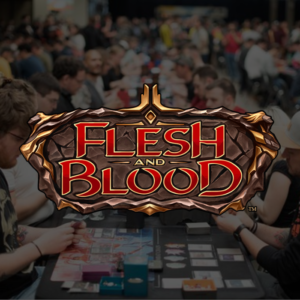How to Play Zen Post Bans
Pro Tour Amsterdam is now right around the corner and in the final days, we want to give you insight into one of the most prominent decks at the event. Whether you’re an experienced Flesh and Blood player or just learned how to play, we’re here to teach you how to play Zen, Tamer of Purpose. With insights from our friend and two-time Irish National Champion, Dylan Thompson, we’ve gained an understanding of what to expect from Zen players at Pro Tour Amsterdam.

Alex Kivitz
The Bonds That Make Us
Why do we expect Zen to show up in force at Pro Tour Amsterdam? Zen has one of the largest card pools in the game, utilizing many sets worth of Ninja cards, and synergistic combo potential with many of the newest mystic cards. Additionally, similarly to the Part the Mistveil draft format, Zen benefits heavily, almost relies on, his hero ability. Lets compare Zen to Katsu, to showcase how the two ninja heroes differ. Katsu is able to discard a zero cost card from hand to tutor a combo card from his deck to play that turn. This ability requires Katsu to hit, and so is easily preventable or made irrelevant if the first hit is already a couple attacks into the turn.
Zen however is able to search his deck for a card as well as create a Crouching Tiger in hand by pitching an Inner Chi. This does not require you to hit and is nearly non-intractable from your opponents side. While this does force you to play the Transcend cards in your deck, these are cards that already pitch for Blue, and while on paper may seem counter-intuitive, make very little difference for the experienced player once the deck is running.
When Zen initially released, players instinctively went for cards like Head Leads Tails and Tiger Swipe, the various cards that buff Crouching Tigers. While these decks saw some success, players soon realized that Zen could play almost any combo line with his ability, and started constructing decks that utilized all varieties of Combo lines. The most prominent quickly became the Dishonor combo line, without the final piece of the combo, Dishonor. What made this deck powerful was the interaction between Bonds of Ancestry and the rest of the Combo cards in the deck, being able to extend turns essentially for free while searching the best cards from your deck.
Bonds of Ancestry (which has almost as many words on it as a George R.R. Martin novel) features a brief narrative on the card, but what it boils down to is that if the attack directly preceding Bonds of Ancestry was a card with “Gustwave” in the name, Bonds of Ancestry’s combo ability would trigger. When it attacks, it allows you to banish a card from your graveyard and search your deck for a card with the same name, banish it, and play it on the same combat chain. It was no surprise decks would run the Blue and Red versions of this card, and some more of the block/combo oriented decks would even run all nine copies. That’s not to say this deck wasn’t already good without Bonds, this simply brought the deck to near astronomical heights in damage output, requiring minimal effort from the players side.
Eventually, this play pattern resulted in the ban of Bonds of Ancestry Blue and Yellow, forcing deck adaptations so that Zen could not blow out the opponent on turns two to four. While doing what it can to curb the power of the deck, Zen still has his consistency and combo potential to remain one of the more powerful heroes in the current Meta-game. Even with these restriction, Zen continues to prove to be a force to be reckoned with.
Out With the Old, In With the New
The biggest part of the ban was the hit on the blue Bonds of Ancestry. Most competitive Zen decks were already simply running three reds and three blues. Some of the more combo/block-out oriented decks did run the three yellows but left the deck susceptible to more targeted counterplay. What the ban mostly did was free up three sideboard slots for for blues to come in and lead to more growth in the core gameplay of the deck.
Let’s go over what has, for the most part, remained the same. The deck of course continues to run three Bonds of Ancestry Red along side much of if not the exact same core. We see three copies of Art of War, Ancestral Harmony, Levels of Enlightenment, Aspect of Tiger: Body, Chase the Tail, Hundred Winds in blue and red, Enlightened Strike, Spinning Wheel Kick red, Tiger Swipe, and all the Common Transcend cards as well Sacred Art: Jade Tiger Domain. You could look at any Zen deck and see basically this same core, maybe some slight alterations based on personal preferences but mostly these cards.
Dylan then walked us through some of his choice picks to round out the deck and why they’re included.
With the three blue Bonds of Ancestry gone, this meant three blues were needed to come into the deck that strengthened the core gameplay aspects we wanted to achieve. The choices here were to add in two Shifting Winds of the Mystic Beast, and one Wind Chakra blue. These three blues have good general synergy with the deck and can be swapped out for key tech cards into other matchups. The Shifting Winds enables more combo potential with some of the newer combo additions to the deck and Wind Chakra being a generic good blue. All three of these block well and can be easily substituted for cards like Snag or This Round’s on Me in the sideboard depending on the matchups.
The next inclusion of note is a single red Harmony of the Hunt. This is a useful card to enable Chase the Tail, however it doesn’t block well and isn’t a combo card. It has it’s strength in enabling an Art of War turn with the Crouching Tiger it creates, but it’s a card you never want to see more than once.
In addition, we have three Mauling Qis for more fire power. These are one cost, three block, combo cards that hit for five, and if they land, deal an additional damage if the attack before them was a Crouching Tiger. Some people have been playing Critical Strike and this is just a Critical Strike with Upside.
Going into more potential blue replacements, we have Captain’s Call blue, a generic blue card with go again that provides two damage. Its an easy transcend enabler. The same is true for blue Be Like Water, if it’s blocked its trading a card for a card, and if it hits, it has lines into red Descendednt Gustwave. Especially if this enables a transcend, you can utilize the free resource from Twelve Petal Kasaya to pay for the cost to change the name.
Winds of Eternity and Fluster Fist are also noteworthy possibilities, with Winds of Eternity allowing for longer games to become more manageable, and recycling using the Hundred Winds, and Fluster Fist being a tutorable Salt the Wounds when paired with Shifting Winds.
Spinning Wheel Kick blue follows the same logic as blue Descendent Gustwave and Hundred Winds. It’s yet another combo card that has innate Go again, and synergistic upside with the red Spinning Wheel Kicks.
Finally, we have some notable equipment changes that could benefit targeted matchups based on other likely heroes we’ll expect at Pro Tour Amsterdam. The core equipment list is fairly consistent across most Zen lists. We have Traverse the Universe, Twelve Petal Kasaya, Tiger Stripe Shuko, Strides of Reprisal, and Tiger Taming Khakkarra. For sideboard, we mostly see Arcane Lanterns, Zephyr Needles, Tide Flippers, and Nullrune Gloves for various levels of arcane damage. We also see some lists running Mask of the Punching Lynx.
With Dash being decently represented at events this season, and her having a good enough matchup, we have Pouncing Paws and Tearing Shuko as good sideboard tech. These help you play around T-Bones while Tearing Shuko is also giving you three points of value.
Prism is always a fan-favorite and we can expect a lot to show up in Amsterdam. While unlikely to happen, there is always the possibility to get trapped in the classic Arc Light Sentinel loop, or at the very least, have an ALS stop what would be a powerful Art of War turn. For these situations, we like to have Time Skippers in sideboard. Even if you don’t use them, having them on the field forces the Prisms to play around and respect the Timeskippers.
One final note that’s a bit more on the “interesting” side is Talisahr. Talishar is an interesting tech piece into the Zen matchup instead of Zephyr Needle. Talisahr is a four power attack and through This Round’s on Me is a three power attack. Zephyr Needle become a one power attack and almost always are broken if so. It’s an interesting option for the mirror match and worth considering.
Final Notes
All in all, the Zen decks of now we feel are just as consistent, and with the ban of the Blue and Yellow Bonds of Ancestry, have forced Zen players to build better all-around decks. The main hit was the blue Bonds of Ancestry, and this has opened up room for more tech cards to enter into the main board. If you’re interested in seeing the full deck, we have a summary of it here.
We hope you found this of any help and we’re so excited to see you all at Pro Tour Amsterdam.
Read more Flesh & Blood articles!

Recap: Pro Tour Amsterdam
A new Pro Tour champion has been crowned! Look back on PT Amsterdam with us!

How To Play Zen Post Bans
How do you play Zen decks post bans? Learn more from our FaB expert Alex!

Part the Mistveil and Pro Tour Amsterdam
Pro Tour Amsterdam is approaching and players worldwide are aiming to become the champion.
